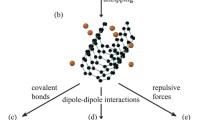Abstract
Using a simple structural model and the multicenter Anderson Hamiltonian, Green’s functions are obtained for the atoms of the zigzag edge of an epitaxial graphene nanoribbon. The electronic structure of the free nanoribbon is discussed in detail. Specifically, expressions for the band spectrum and density of states are found and estimates of the occupation numbers and magnetic moments are given. For a nanoribbon strongly bonded to a metal substrate, the criteria for the appearance of magnetic moments are determined. As it is shown for both free and epitaxial nanoribbons, the probability of the appearance of magnetic moments and their magnitude for zigzag edge atoms that have two nearest neighbors is higher than for atoms with three nearest neighbors.




Similar content being viewed by others
REFERENCES
M. K. Slota, A. Keerthi, W. K. Myers, E. Tretyakov, M. Baumgarten, A. Ardavan, H. Sadeghi, C. J. Lambert, A. Narita, K. Müllen, and L. Bogani, Nature (London, U.K.) 557, 691 (2018).
F. Luis and E. Coronado, Nature (London, U.K.) 557, 645 (2018).
M. Fujita, K. Wakabayashi, K. Nakada, and K. Kusakabe, J. Phys. Soc. Jpn. 65, 1920 (1996).
T. L. Makarova, Semiconductors 38, 615 (2004).
E. Kan, Z. Li, and J. Yang, Nano 3, 433 (2006).
K. S. Novoselov, A. K. Geim, S. V. Morozov, D. Jiang, Y. Zhang, S. V. Dubonos, I. V. Grigorieva, and A. A. Firsov, Science (Washington, DC, U. S.) 306, 666 (2004).
Y.-W. Son, M. L. Cohen, and S. G. Louie, Nature (London, U.K.) 444, 347 (2006).
V. Barone, O. Hod, and G. E. Scuseria, Nano Lett. 6, 2748 (2006).
O. V. Yazyev, Rep. Prog. Phys. 73, 056501 (2010).
V. Meunier, A. G. Souza Filho, E. B. Barros, and M. S. Dresselhaus, Rev. Mod. Phys. 88, 025005 (2016).
D. Pesin and A. H. MacDonald, Nat. Mater. 11, 409 (2012).
P. Recher and B. Trauzettel, Nanotechnology 21, 302001 (2010).
S. Yu. Davydov, Semiconductors 53 (2019, in press).
P. W. Anderson, Phys. Rev. 124, 41 (1961).
Ch. Kittel, Quantum Theory of Solids (Wiley, New York, 1963; Nauka, Moscow, 1967), Chap. 18.
S. Alexander and P. W. Anderson, Phys. Rev. A 133, 1594 (1964).
J. M. Ziman, Principles of the Theory of Solids (Cambridge Univ. Press, Cambridge, 1964).
T. Moriya, Spin Fluctuations in Itinerant Electron Magnetism (Springer, Berlin, 1985; Mir, Moscow, 1988).
S. Yu. Davydov, Sov. Phys. Solid State 21, 1314 (1979).
S. Yu. Davydov, Adsorption Theory: Model Hamiltonian Method (SPbGETU LETI, St. Petersburg, 2013) [in Russian]. twirpx.com/file/1596114/.
F. D. M. Haldane, and P. W. Anderson, Phys. Rev. B 13, 2553 (1976).
S. Yu. Davydov, Phys. Solid State 54, 2329 (2012).
S. Yu. Davydov, Phys. Solid State 58, 1222 (2016).
T. O. Wehling, E. Sasioglu, C. Friedrich, A. I. Lichtenstein, M. I. Katsnelson, and S. Blügel, Phys. Rev. Lett. 106, 236805 (2011).
S. Yu. Davydov, Phys. Solid State 60, 812 (2018).
I. S. Gradshtein and I. M. Ryzhik, Tables of Integrals, Series and Products (Academic, New York, 2000; Fizmatgiz, Moscow, 1962).
P. F. Bird and M. D. Friedman, Handbook of Elliptic Integrals for Engineers and Scientists (Springer, Berlin, 1971).
Author information
Authors and Affiliations
Corresponding author
Ethics declarations
The author states that he has no conflicts of interests.
Additional information
Translated by O. Kadkin
APPENDIX
APPENDIX
To find the occupation numbers, it is necessary to calculate the following integrals:
where ω1(0) = t(\(\sqrt {17} \) + 1)/2, ω2(0) = t(\(\sqrt {17} \) – 1)/2, ω1(π/2a) = t, and ω2(π/2a) = Δ. Using the handbook [26] (formulas 3.147–3.149), we obtain the following expressions for the J–, S–, and P– integrals:
where K(η) and Π(n, η) are the complete elliptic integrals of the first and third kind [26, 27], F(φ, η) and Π(φ, n, η) are the incomplete elliptic integrals of the first and third kind [26, 27],
and
For what follows, we need to expand the J+, S+, and P+ integrals over φ = π/2 – β, where β ≈ \(\sqrt {\Delta {\text{/}}t} {\text{/}}2\)\( \ll \) 1. Based on the definition of the F(φ, η) and Π(φ, n, η) integrals and assuming
we get
Thus, preserving only terms with ~\(\sqrt {\Delta {\text{/}}t} \) and taking into account relation Π(–η, η) = [π + 2(1 + η)K(η)]/4(1 + η) [27], we come to formulas (18).
Rights and permissions
About this article
Cite this article
Davydov, S.Y. Magnetic States of the Zigzag Edge of a Graphene Nanoribbon. Phys. Solid State 62, 223–229 (2020). https://doi.org/10.1134/S1063783420010084
Received:
Revised:
Accepted:
Published:
Issue Date:
DOI: https://doi.org/10.1134/S1063783420010084




